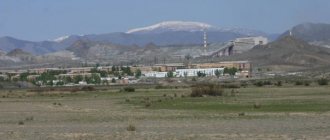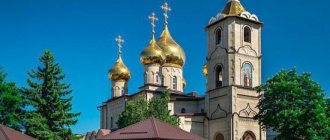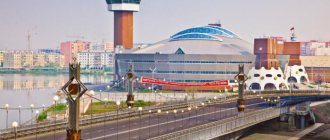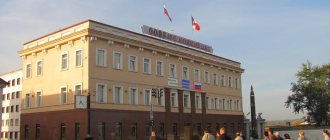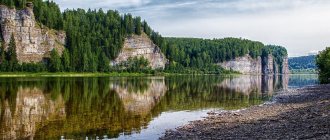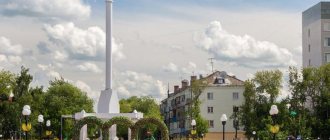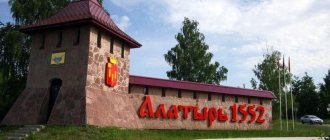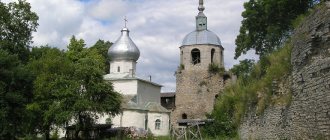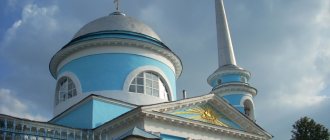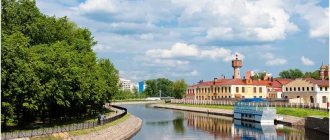The city of Neryungri is located in Southern Yakutia and is the center of the region of the same name. National composition: Russians, Yakuts and Evenks. In 2016, 57,791 people lived there, which is quite a lot for the Republic of Sakha. The city of Neryungri is the second largest in it. It was formed on November 6, 1975, on the basis of a concentration of geological exploration parties, a settlement of miners and workers of the territorial production complex. In modern Russia, this cultural and industrial center is considered quite promising. This is largely facilitated by the fact that the federal highway Lena and the Berkakit - Tommot - Yakutsk railway pass through it.
| Population: 57,791 people. | City area: 93.00 km2 |
| Time zone:UTC +9 | Telephone code:+7 (41147) |
| Postal code:678960 | Automotive region:14 |
| Housing cost per m2: RUR 29,194. | Average salary: RUB 36,066. |
Neryungri on the map of Russia
The region of Eastern Siberia, where Neryungri is located, belongs to sharply continental climatic zones. In winter, temperatures can drop to -61°C. True, this is an absolute minimum; such frosts do not happen very often. Usually the temperature is kept at 30-35 °C. In summer, the air temperature can rise to + 34 °C.
The city of Neryungri in Yakutia lies at the same latitude as Moscow and is located on the right bank of the Chulman River, in an area with a rather complex topography of the spurs of the Stanovoy Range, so the topography of the streets is also rugged, but some parts of the city are located in the lowlands that form the valleys of the Ammunakta and Chulman rivers .
The distance from Yakutsk to Neryungri along the Lena highway is 810 km.
You can get to the city not only by car or train, but also by plane. 40 km from it is Neryungri Airport, owned by FKP Airports of the North. The second name is “Chulman”, after the name of the village located 8 km from it. This is a civil airport, which was created taking into account the possibility of receiving large aircraft, such as the An-124 Ruslan or Boeing 757-200. Regular air connections are provided with Moscow, Irkutsk and Novosibirsk.
Timpton Cascade
It is one of the attractions of Neryungri, carrying clean spring waters and spewing them out with several dozen springs. The location is the Timpton River Valley. Melt water maintains above-zero temperatures all year round; ice does not form even in the most severe frosts.
The cascade is located 50 km from the village of Chulman, on whose territory the airport operates. Experts agree that the creation of the Cancun hydroelectric power station could cause irreparable damage to the natural monument.
Another place worthy of attention is the Nakhot thermal spring. Even in winter, the hot spring does not freeze and is a delight. A recreation center of the same name with comfortable rooms was built in the immediate vicinity.
The healing water maintains a temperature of +30 °C throughout the year. During the Soviet era, it was planned to create an all-Union large-scale health resort here. However, before the collapse of the state, only a road was built. The designated recreation center appeared in the 90s on the initiative of enthusiasts.
City map
Neryungri is a rather small town by Russian standards. But for a traveler who comes here for the first time, it won’t be difficult to get lost. Therefore, before visiting it, we suggest that you carefully study the map of Neryungri with streets given below.
The city is divided into 12 quarters. The central ones are blocks A, B and K. You can download a more detailed map of Neryungri with blocks here.
Links[edit]
Notes[edit]
- ^ abcdefghijk Register of administrative-territorial units of the Republic of Sakha
- ^ abc Federal State Statistics Service (2011). “All-Russian Population Census 2010. Volume 1" [All-Russian Population Census 2010, vol. 1]. All-Russian Population Census 2010 [All-Russian Population Census 2010]
. Federal State Statistics Service. - "26. The size of the permanent population of the Russian Federation by municipalities as of January 1, 2022". Federal State Statistics Service. Retrieved January 23, 2022.
- ^ abcd Law No. 173-Z No. 353-III
- Law No. 172-Z No. 351-III
- "On the Calculation of Time". Official Internet portal of legal information
. June 3, 2011. Retrieved January 19, 2022. - Post office. Information and computing center of OASU RPO. ( Post office
).
Search for postal service objects ( postal Search for objects
) (in Russian) - ↑
Federal State Statistics Service of Russia (May 21, 2004).
“The population of Russia, the constituent entities of the Russian Federation as part of federal districts, urban settlements, settlements, settlements of 3 thousand or more people” [Population of Russia, its federal districts, federal districts, districts, urban settlements, rural settlements - administrative centers and rural settlements with a population of more than 3,000 people] (XLS). All-Russian Population Census 2002
. - “All-Union Population Census of 1989. The current population of union and autonomous republics, autonomous regions and districts, territories, negative phenomena, urban settlements and villages. All-Union Population Census of 1979. National composition of the population by regions of Russia” [All-Union Population Census of 1979. Ethnic composition of the population by regions of Russia] (XLS). All-Union Population Census of 1979 [All-Union Population Census of 1979]
.
1979 - via Demoscope Weekly
(website of the Institute of Demography of the State University - Higher School of Economics. - "Weather for Neryungri". Retrieved December 17, 2016.
Sources [edit]
- Official website of the Republic of Sakha. Register of administrative-territorial units of the Republic of Sakha
. Neryungri district. (in Russian) - State Assembly (Il Tumen) of the Republic of Sakha (Yakutia). Law No. 172-Z No. 351-III of November 30, 2004 “On establishing boundaries and granting municipal district status to municipal formations of the Republic of Sakha (Yakutia)”, as amended. Law No. 1535-Z No. 597-V of November 27, 2015 “On amendments to Articles 1 and 2 of the Law of the Republic of Sakha (Yakutia) “On establishing boundaries and on granting the status of a municipal district to municipal formations of the Republic of Sakha (Yakutia).” Came into force on the date of official publication. Published: “Yakutia”, No. 245, December 31, 2004 (State Assembly (Il Tumen) of the Republic of Sakha (Yakutia). Law No. 172-Z No. 351-III of November 30, 2004. On establishing boundaries and assigning municipalities of the Republic Sakha (Yakutia) status of a municipal district
as amended by the Law of November 27, 2015 No. 1535-Z No. 597-V "
On amendments to Articles 1 and 2 of the Law. Law of the Republic of Sakha (Yakutia) "On establishing boundaries and granting the status of a municipal district municipalities of the Republic of Sakha (Yakutia)"
. Valid from the date of official publication.). - State Assembly (Il Tumen) of the Republic of Sakha (Yakutia). Law No. 173-Z No. 353-III of November 30, 2004 “On establishing boundaries and granting the status of urban and rural settlements to municipalities of the Republic of Sakha (Yakutia)”, as amended. Law No. 1058-Z No. 1007-IV of April 25, 2012 “On amendments to the Law of the Republic of Sakha (Yakutia) “On the establishment and granting of the status of urban settlements to municipalities of the Republic of Sakha (Yakutia).” Came into force on the date of official publication. Published: “Yakutia”, No. 245, December 31, 2004 (State Assembly (Il Tumen) of the Republic of Sakha (Yakutia). Law No. 173-Z No. 353-III of November 30, 2004. On establishing boundaries and granting municipalities of the Republic Sakha (Yakutia) status of urban and rural settlements
as amended by Law No. 1058-Z No. 1007-IV dated April 25, 2012
Republic of Sakha (Yakutia) “On establishing boundaries and granting municipalities of the Republic of Sakha (Yakutia) the status of urban and rural settlements”
Valid from the date of official publication.).
City `s history
Despite the fact that the city was formed only in the mid-70s of the 20th century, settlements in this place existed for a very long time, since 1643, when the first expeditions began to be sent to these regions. The most rapid period of development during the period of Tsarist Russia should be considered the 19th century. Already by the middle of it, more than 80 mines were operating in the Timpton River valley, and the territory was inhabited by gold miners and local Evenks, who were guides and workers.
Since 1967, two-story residential buildings, sewage treatment plants, a boiler room, a car garage, a hospital, a school, a store, a canteen, a bakery, and a high-voltage power line from Chulman to Neryungri appeared in the then village. On June 15, 1975, seven kilometers from the village, the Yakutuglestroy plant began construction of a new city, and on November 6 of the same year, the working village of Neryungri was transformed into a city of republican subordination.
The first blocks of the new city of Neryungri began to be built up with wooden two-story houses. At the end of 1980, the first Neryungri residents moved into a house made from panels from the Neryungri KPDS plant. In 1985, the first nine-story buildings appeared here. Currently, Neryungri is a major administrative, industrial and cultural center of Southern Yakutia.
Neryungri was designed according to generally accepted standards in the USSR and, nevertheless, has a strong individuality. The mountainous landscape made construction difficult, but it also suggested original spatial solutions that distinguish the city from many northern cities, and the brightly colored facades of houses, balconies and loggias, and small architectural forms give it a special flavor. In 1990-2000, Neryungri was repeatedly awarded a diploma from the All-Russian competition for the best landscaping.
Actor and Puppet Theater
Such a complex in Neryungri is the only one known throughout the Far East. The history of the theater dates back to 1985. It was opened by order of the Minister of Culture with the aim of improving the moral and aesthetic education of the youth of Yakutia.
One of the first to perform on stage was S. V. Obraztsov, People's Artist of the USSR. It was his recommendation that worked, according to which A.K. Yartsev was sent from the State Puppet Theater to Yakutia as the chief director. After such events, the first famous actors arrived in Neryungri to create a cohesive team.
The city of Neryungri today
Neryungri is one of the highest mountain cities in Yakutia, its average height above sea level is 837 m. The entire city is built on the slopes and flat peaks of the mountains of the Stanovoy Range, while its individual areas are located in the lowlands. Thus, the Neryungri-Passenger railway station is located in the valley of the Ammunakty river, the old city is in the valleys of the Chulman, Upper and Lower Neryungri, and Maly Berkakit rivers.
If we take the monument to Lenin, which stands on the square near the administration building, as the city center, then the distance from the center of Neryungri to the Chulman River in a western direction is 3.75 km. As for transport, there is no airport directly in the city - it is located in the village of Chulman, approximately 30 km from Neryungri. There is a railway station on the outskirts of the city to the east. The M56 highway passes through the villages of Serebryany Bor and Chulman: in the northern direction - towards Yakutsk, and in the southern direction - towards the Amur region of Tynda. Buses in the city of Neryungri run on schedule. The Neryungri bus schedule is updated annually and approved by the city administration.
In a modern and actively developing city, there is everything you need for life: here you can rent an apartment, go to a restaurant, a night club or even a theater. The city has two universities, several gymnasiums, secondary educational institutions, music, art and sports schools. By the way, local residents affectionately call their city Nyurka.
Transport support
Today there are no problems with transport in the area. The only railway in the Amuro region, the Yakutskaya Railway, passes through Neryungri. From the city you can travel by train to Aldan, Tommot and Nizhny Bestyakh (the station was put into operation in 2022), and in the opposite direction to any corner of Russia. The travel time of the direct train Neryungri – Moscow is 5 days.
35 km. From the city there is the Chulman airport. Twice a week there are flights Neryungri - Moscow, Neryungri - Novovsibirsk, as well as flights to Yakutsk, Khabarovsk, Irkutsk and Krasnoyarsk. The airport is expected to undergo reconstruction in 2022.
Travel time to Yakutsk along the Lena highway will be approximately 12 hours. Approximately 2 times a week such flights are carried out from the city to the capital of the republic, exclusively by private cabs.
There is a daily commuter bus service between the village. Serebryany Bor, town. Chulman, village Berkakit, village Iengra.
In the city itself you can use both bus and taxi.
Bus routes: No. 3, No. 4, No. 5, No. 2, No. 12, No. 8.
Taxi companies: “Lux”, “Grand”, “Favourite”, “Indriver”, etc.
Network city Neryungri
Network city. Education is a comprehensive information system that unites all city schools and educational authorities into a single network. The city of Neryungri has also implemented such a system. Network city. Education Neryungri , also called Netschool (Netschool) - helps specialists of the education authority monitor student progress, monitor the work of teachers, teachers, directors, and quickly share important information and educational materials with everyone. Each user of an educational institution (director, head teacher, student, teacher, etc.) and parents of students have an individual name and password and can log into the system from any computer connected to the municipal network (or the Internet). You can also enter the network city through the State Services data.
The good thing about this system is that each user can use it simultaneously without interfering with each other. Each Neryungri school posts information to the network city independently and is the owner of its information.
The network city also implements an electronic diary of Neryungri, with the help of which any parent can monitor the progress of their children and communicate online with teachers and school administration. Each student can log into their electronic diary and see their homework, weekly schedule, etc.
You can find out more detailed information about this system and register.
Climate[edit]
Neryungri has a subarctic climate (according to the Köppen climate classification Dfc
) with mild summers and harsh winters.
Precipitation is moderate, but in summer it is much higher than at other times of the year. The climate is extremely cold for the latitude, in part due to the Siberian High bringing extremely cold polar air to the city in winter, while the relatively high altitude and proximity to the cold Sea of Okhotsk generally prevent the heat waves seen in the lower Sakha regions. Climate data for Neryungri
| Month | Jan | Feb | Mar | Apr | May | Jun | Jul | Aug | Sep | October | But I | December | Year |
| Record high °C (°F) | -5,6 (21,9) | -1,2 (29,8) | 7,4 (45,3) | 17,6 (63,7) | 28,1 (82,6) | 34,6 (94,3) | 34,8 (94,6) | 33,1 (91,6) | 26,3 (79,3) | 17,7 (63,9) | 4,6 (40,3) | -1,8 (28,8) | 34,8 (94,6) |
| Average high °C (°F) | -26,8 (-16,2) | -20,6 (-5,1) | -10,6 (12,9) | -0,1 (31,8) | 9,8 (49,6) | 19,5 (67,1) | 21,8 (71,2) | 18,8 (65,8) | 9,3 (48,7) | −3 (27) | -17,5 (0,5) | -26,3 ( -15,3 ) | −2,1 (28,2) |
| Daily average °C (°F) | -30,4 (-22,7) | -25 (-13) | -15,8 (3,6) | -4,8 (23,4) | 4,6 (40,3) | 13,4 (56,1) | 16,1 (61,0) | 13,0 (55,4) | 4,5 (40,1) | −7,1 (19,2) | -21,2 (-6,2) | -29,8 (-21,6) | -6,9 (19,6) |
| Average low °C (°F) | -33,9 (-29,0) | -29,2 (-20,6) | -21,2 (-6,2) | -9,7 (14,5) | -0,4 (31,3) | 7,7 (45,9) | 10,9 (51,6) | 7,9 (46,2) | 0,2 (32,4) | -10,9 (12,4) | -24,8 (-12,6) | -33,1 ( -27,6 ) | -11,4 (11,5) |
| Record low °C (°F) | −61 (−78) | -56,9 (-70,4) | -49,8 (-57,6) | -37 (-35) | -21,6 (-6,9) | -6,4 (20,5) | -3,7 (25,3) | −8 (18) | -18,9 (-2,0) | -38,7 (-37,7) | -50,8 (-59,4) | -57,9 (-72,2) | −61 (−78) |
| Average precipitation, mm (inches) | 15 (0,6) | 12 (0,5) | 14 (0,6) | 28 (1,1) | 52 (2,0) | 91 (3,6) | 108 (4,3) | 91 (3,6) | 79 (3,1) | 50 (2,0) | 27 (1,1) | 16 (0,6) | 583 (23,1) |
| Source: [11] | |||||||||||||
Population of Neryungri
As of 2016, the population of Neryungri is 57,791 people. The main nationalities are Russians (92%) and Yakuts (5%). The indigenous inhabitants, the Evenks, remained only in the village of Iengra and some villages. The bulk of the population of Neryungri are the descendants of those who came here to build the famous Baikal-Amur Mainline. People are mostly friendly, the mentality of Siberia and the Far East prevails. The attitude towards visitors is neutral; residents do not have any special preferences or hostility. If you get lost in this small town, ask people you meet for help and be sure that they will not refuse you.
Business life
The most promising area of activity in the region today is entrepreneurship. The number of people employed in small and medium-sized businesses is approximately 8,000 people.
To support business and interaction, the following were created: Association of Young Entrepreneurs; Public Coordination Council for Entrepreneurship, District Entrepreneurship Council. These structures provide assistance and support to small and medium-sized businesses and entrepreneurship in the area.
Industry
Neryungri is famous for the largest deposit of coking coal in Russia. Coal is mined here in open pits in large open pits. Coal mining is the main industry in the city of Neryungri. One of the most important enterprises of the city is the Closed Joint-Stock Company "Small Open-Gap Neryungri".
The company was founded relatively recently - in 2000. Most of the residents are employed in auxiliary production of the territorial production complex. This is a coking coal processing plant, a plant for the repair of mining equipment, and a state district power station.
Museum named after I. I. Pyankov
Any traveler should visit this historical place, dedicated to the difficult development of South Yakutia. The museum has been operating since 1976, named after Ivan Pyankov, who was one of the first leaders of the new city. He made a significant contribution to the development of the attraction.
The new exhibition appeared at the beginning of 1992. It introduces visitors to the flora and fauna of the southern part of Yakutia. Here you can come into contact with the spiritual culture of the local northern inhabitants, the ancient history of the harsh region and its first explorers, and examine the mineral resources available in the region. The exhibition also tells:
- on geological exploration of a territory little developed by man;
- industrial development;
- construction of the Small BAM;
- construction of a territorial production complex;
- creation of the city.
Attractions
The peculiarity of the sights of Neryungri is that they are all either natural or modern. The buildings that were erected before 1940 have not survived. However, travelers will find something to see.
Bottle Rock
First of all, mention should be made of the Bottle Rock in the Neryungri ulus. The rock of this rock has a special structure - it resembles compressed broken glass, which was the reason for its name.
It is located 100 km from the city and belongs to the Stanovoy Range. Since ancient times, many beliefs have been associated with this rock. The simplest thing is that long contemplation of it can heal eye diseases. More romantic is that the contemplator, if he looks correctly, will see in the depths of the rock the Bird of Destiny, which will reveal to him the secrets of the universe and the purpose of his own life.
Getting to the rock is not so easy. Cars cannot drive closer than 30 km - the dense taiga begins. They make their way on foot, with great difficulty. The Evenks joke that this rock will either heal or send you to the next world. The main mineral of the rock is chrome diopside, which translated from Greek means “shape-changing stone.” And indeed, there are people who claim that they see a bird inside the rock. Maybe it's a hallucination, maybe some kind of optical effect. There is also a version that this bird is man-made and placed inside by the legendary master Soshnikov, who is the local analogue of Danila the Master or the Tula Lefty.
Timpton Cascade
The spring waters of the Timpton Cascade are also of some interest. These are more than 50 springs that flow with the purest melt water. They are located next to each other, among the stones, in the peculiar valley of the Timpton River. The water does not freeze even in the most severe frosts.
The cascade is located 55 km from the village of Chulman, the same one where the airport is located. Local historians fear that the springs could be damaged by the planned construction of the Cancun hydroelectric power station, so it wouldn’t hurt to look at them and taste the water now.
Nahot
Separately, it is worth highlighting the Nakhot thermal spring in Neryungri. As we already know, the weather here in winter is frosty. All the more admirable is the hot spring, which is located 30 km from the city and 23 from Chulman along a dirt road. A recreation center of the same name “Nakhot” was built next to it.
The temperature of the healing water is always + 32 °C, even if there is severe frost around. Once upon a time, during the years of the USSR, they planned to build a huge all-Union health resort here, but the state ceased to exist. We only managed to pave the road. And the Nahot recreation center was opened in the mid-90s by enthusiasts.
Museum of the History of the Development of South Yakutia named after. I.I. Pyankova
The most interesting museum for a traveler in Neryungri may be the Neryungri Museum of the History of the Development of South Yakutia named after. I. I. Pyankova. It was founded in 1976 on a voluntary basis. For some time it was called the “Neryungri Museum of the History of the Construction of the Small BAM and the South Yakutsk TPK,” but soon it was renamed and named after Ivan Pyankov, one of the first leaders of the city, who made a great contribution to the development of the museum.
In February 1992, a new exhibition was opened here, prepared by the museum staff together with the methodological center of the Moscow State Historical Museum. The museum's exposition presents the flora and fauna of Southern Yakutia, local minerals, information about the ancient history of the region, Russian explorers, and the material and spiritual culture of the indigenous peoples of the North. Here you can get acquainted with the geological study of the South Yakut region and the history of its industrial development, learn about the construction of the South Yakut territorial production complex, the Small BAM and the city of Neryungri itself. Address: st. Pioneernaya, building 4/1. Phones: +7 (41147) 441-82, +7 (41147) 439-33.
Actor and Puppet Theater
In Neryungri there is the only Actor and Puppet Theater in Siberia and the Far East. The history of the puppet theater began in 1985, when the Minister of Culture of the RSFSR Melentyev signed an order to create the theater “in order to further improve the aesthetic and moral education of the younger generation of Yakutia.” The birth of the theater was first welcomed by People's Artist of the USSR, Hero of Socialist Labor Sergei Vladimirovich Obraztsov.
On his recommendation, Andrei Konstantinovich Yartsev arrived from the State Central Puppet Theater and was appointed chief director of the theater. It was from this moment that work began on creating a theater team - the first actors arrived in Neryungri. The first performance was staged based on V. Korostylev’s play “What the Wizards Told About.” In 1992, the need arose to serve not only children, but also adults. On the initiative of artistic director Igor Utkin, the institution was given a new status - Actor and Puppet Theater. Address: st. Pioneernaya, house 4a. Phones: +7 (41147) 470-71, +7 (41147) 444-85.
Employment Center
It is unlikely that the employment center can be called a landmark of Neryungri, but its work should inspire respect among guests and residents of the city. The employment center is located at: Neryungri, st. Oyunskogo 1/1, phone: +7 (41147) 435-40. All those who come to this city in search of work on a rotational basis or on a permanent basis are required to visit it. Only here you can get a list of all available vacancies in the city of Neryungri in a short time. This center will tell you which company is best for you to find a job, which of them provide a social package, where they pay the most, etc.
Gornyak Stadium
On the territory of the city of Neryungri there is one of the largest sports facilities in the Far East - the indoor stadium "Gornyak". Construction of this sports facility with 3 thousand seats began in May 2006. On August 24, 2007, the opening ceremony took place. This facility became the largest of all that were built in the capital of South Yakutia in preparation for the 55th anniversary of the development of the republic’s coal deposits. In addition to the football field, the stadium has athletics tracks, a gym, and rooms for table tennis and aerobics. Address: st. Churapchinskaya, house 33.
With the opening of the Horizon ski resort in 2010, the stadium began a new chapter in sports life. The range of health services provided has expanded, and rental of downhill and cross-country skis, snowboards and tubing has been organized. In 2012, a significant event for the base was the holding of the second winter Olympics in alpine skiing and snowboarding. Since then, the Russian national biathlon team has regularly trained on the roller ski track.
In total, there are 143 sports facilities in the Neryungri district: the Shakhtar and Bogatyr sports complexes, an indoor skating rink, gyms and swimming pools, tennis courts.
The city has its own radio; two federal channels provide time for local television. Among the entertainment establishments, there is a Burger Club restaurant and the famous beer restaurant “Zastolye”. There is also a printing house where more than 10 newspapers are published, and one of them is called “Simply Nyurka”. The fact is that the residents jokingly call their city Nyurka. Local media is known not only for its paper form, but also for its online form.
So, Neryungri is far from the last place on the map of Yakutia and Russia. Despite the small number of inhabitants, this region brings many benefits, is rich in minerals and famous for its traditions. It is worth visiting first of all in order to feel the spirit and special beauty of Siberia.
Bottle Rock
This is a unique place located in the Neryungri ulus. The rock is distinguished by its rock, which in appearance resembles fragments of compressed broken glass. It is located outside the city (100 km) on the territory of the Stanovoy Range. Since ancient times, people have attributed miraculous properties to this place, one of which indicates the healing of eye diseases through ordinary contemplation of the rock. Some old-timers claim that when looking at the natural massif for a long time, you can see the Bird of Happiness; it will point a person to the secrets of the universe.
The path to Bottle Rock is not easy. To get there you will have to walk many kilometers through dense taiga, which can be dangerous. The Evenks claim that this place can heal or destroy the soul. The rock contains the mineral chrome diopside, the so-called “shape-changing stone.” Some tourists confirm that they can see a bird in the depths of a block of stone. These may be hallucinations, but one version indicates that such a figurine was created and placed inside by a local craftsman.
